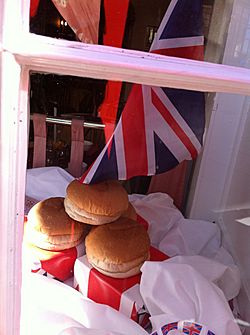Sally Lunn bun facts for kids

Sally Lunn Buns
|
|
| Alternative names | Sally Lun, or Lund, Solemena, soel leme |
|---|---|
| Type | Sweet bread |
| Place of origin | England |
| Region or state | Bath, Somerset |
| Variations | Solilemmes |
A Sally Lunn is a yummy, big bun or teacake. It's made with a special dough that has yeast, cream, and eggs. It's a bit like the sweet brioche breads from France. People usually eat it warm, sliced, and with butter. The first time anyone wrote about it was in 1780. This was in Bath, a spa town in southwest England. It's a popular treat for tea time in Canada, England, and New Zealand. There, it's often served warm or toasted.
There are many kinds of Sally Lunn cake in American cuisine. Some are made with yeast. Other versions add cornmeal, sour cream, or buttermilk to the basic recipe. British colonists brought the recipe to the United States. New American versions were created through the 1700s and 1800s. One newspaper article from 1892 claimed that Sally Lunn bread became known as "Washington's breakfast bread." This was because George Washington liked it so much.
Contents
What's the Story? The Origins of Sally Lunn Buns
The true story of the Sally Lunn bun is a bit of a mystery. One idea is that its name comes from "Soleil et lune." This is French for "sun and moon." It might describe the golden top and white inside of the bun.
The Sally Lunn Eating House in Bath, England, has its own story. They say the recipe came to Bath in the 1680s. It was supposedly brought by a Huguenot refugee named Solange Luyon. She then became known as Sally Lunn. However, there is no real proof for this story. A report from The Daily Telegraph in 2015 called it a "charming tale, but, sadly, a fictitious one."
Early Mentions of the Bun
The bun was first mentioned in a poem in 1776. It was written by the Irish poet William Preston. He wrote about "Sally Lunn and saffron cake" in Dublin. The first time the bun was mentioned in Somerset was in 1780. This was in a guidebook by Philip Thicknesse about visiting Bath.
Thicknesse wrote about people drinking lots of Bath water. Then they would eat "Sally Lunns or hot spungy rolls, made high by burnt butter!" He warned against this. He said such a meal could make young men sick.
Who Was Sally Lunn?
There isn't much proof that Sally Lunn was a real person. In 1798, The Gentleman's Magazine talked about foods named after people. They used "Sally Lunns" as an example of hot rolls popular in Bath.
It wasn't until 1827 that someone described a historical person named Sally Lunn. A writer using the name "Jehoiada" said she sold the buns on the street "about thirty years ago." A baker named Dalmer later bought her business. He made it very successful. He even wrote a special song for the people who sold the buns from mobile ovens. The earliest advertisement for Sally Lunn "cakes" was in 1819. It was for W. Needes of Bath, a baker to the Prince Regent.
Sally Lunns were also mentioned in books. Charles Dickens wrote about them in his 1844 novel The Chimes. He mentioned them along with muffins and crumpets. In 1845, Eliza Acton included a recipe for Sally Lunn in her book Modern Cookery for Private Families. She called it a version of "Solimemne - A rich French breakfast cake, or Sally Lunn." Solilemmes is a type of brioche. It was made popular by the famous Parisian chef Marie-Antoine Carême in 1815.
The Famous Sally Lunn's House
The old building now known as the Sally Lunn Eating House is in Bath. It's at 4 North Parade Passage (51°22′51″N 2°21′30″W / 51.3808°N 2.3582°W). This place was once part of Bath Abbey. The lowest floor was built after a big fire in 1137. The old oven in the basement is from that time.
In the 1930s, Marie Byng-Johnson bought the building. She opened it as a tea-room. It became famous for Sally Lunn buns. She promoted a story that she found an old paper in a secret panel. It supposedly said that Mlle. Sally Lunn was a young French refugee. It claimed she brought the recipe to Bath around 1680. The building is now a Grade II* listed building. This means it's a very important historical building.


